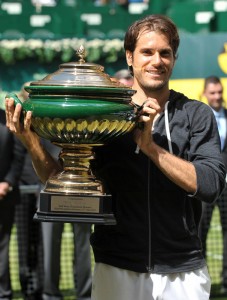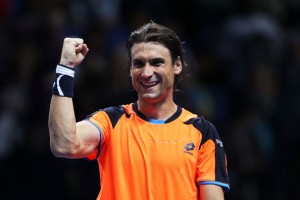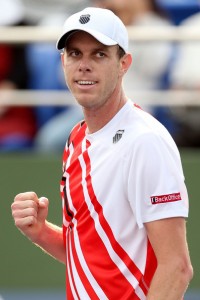Tommy Haas, No.21
As I write, Tommy Haas is losing amiably to Roger Federer at an exhibition in Sao Paulo, although he earlier proved beyond question that he is the Swiss player’s superior as a dancer. He also demonstrated back in Halle that he could master Federer in a tour final, even one whose mood was almost as unbuttoned as an exo.  The Halle title was arguably the high-point of an outstanding year for Haas, which saw him rise from No.205 to No.21, turn thirty-four, and remain, by his standards, injury-free (he only gave away two walkovers and one retirement). His assertion some time ago that he still has top-class tennis in him, and that he is determined still to be playing it when his daughter is old enough to appreciate it, seemed more than a little fanciful. However, I can attest that those who expressed scepticism can still number among the German’s ardent admirers.
The Halle title was arguably the high-point of an outstanding year for Haas, which saw him rise from No.205 to No.21, turn thirty-four, and remain, by his standards, injury-free (he only gave away two walkovers and one retirement). His assertion some time ago that he still has top-class tennis in him, and that he is determined still to be playing it when his daughter is old enough to appreciate it, seemed more than a little fanciful. However, I can attest that those who expressed scepticism can still number among the German’s ardent admirers.
Halle aside, my favourite moment came when Haas was denied a wildcard into Roland Garros, so promptly qualified without dropping a set, and pushed through to the third round, at which stage he unfortunately discovered Richard Gasquet on that one day a year when the Frenchman forgets how to miss the court. For Haas, Paris continued a run of form that commenced in Munich, and would be sustained with only minor interruptions until the year’s end. Along the way he defeated nine top 20 players, for only six losses. He’ll be comfortably seeded in Melbourne next month. The other highlight was of course his 500th career victory, which came in Vienna, and for which he received a Fiat.
Certain though I am of Haas’ daughter’s unfettered precocity, I also hope she’s rather slow on the uptake when it comes to her father’s chosen sport, and that he might therefore hang around for a while yet.
David Ferrer, No.5
In 2012 David Ferrer won 76 matches, the most of any player on tour. He is ranked No.5, a position that he has transformed from being an abstract number into a kind of Hadrian’s Wall dividing the top ten. Metaphorically, I can’t quite decide whether he patrols this wall (which would thus permit me to unleash some of the requisite canine allusions), or whether he in fact is the wall. Against the four players above him he compiled a record of 1-9, with the lone victory against Murray at the French Open.  Against those ranked below his record was 75-6, including 8-0 against those ranked between 6 and 10, including comprehensive wins over Juan Martin del Potro, some gripping victories over Janko Tipsarevic, and thrashing Tomas Berdych in the David Cup final. He isn’t the kind of player who has bad years, but this year was without doubt his best.
Against those ranked below his record was 75-6, including 8-0 against those ranked between 6 and 10, including comprehensive wins over Juan Martin del Potro, some gripping victories over Janko Tipsarevic, and thrashing Tomas Berdych in the David Cup final. He isn’t the kind of player who has bad years, but this year was without doubt his best.
For all that I’m drawn to a complicated view of things, and generally resist easy categorisations, I admit I appreciate the way Ferrer so clearly and straightforwardly separates the top four from the rest. Despite finally claiming a Masters title, he doesn’t belong among the truly elite. Yet nor is he the best of the rest.  He is considerably better than the rest. This is especially true of the young players on the way up, in whom the mere sight of Ferrer’s name near theirs in a draw must reduce them to desolation. Whether you’re Tomic or Raonic or Janowicz, he is a wall that can be neither penetrated nor scaled. It’s a shame for them, as it’s a shame for everyone ranked below him, but for the rest of us there’s something gratifying about it. We know where we stand with Ferrer, and he has worked tirelessly to ensure we know where everyone else stands, too.
Radek Stepanek, No.31
When Radek Stepanek and Leander Paes defeated the Byran Brothers to claim the Australian Open doubles title, there was a real risk that advancing age and the opportunity to share his outlandish victory celebrations with a kindred spirit might see him become a full-time double specialist. This transition remains on the cards, even though Stepanek still claims his share of singles matches. Then again, if he never contests another singles match he probably won’t care, since in the last one he played he defeated Nicolas Almagro in the fifth and deciding rubber of the Davis Cup final, securing it for the Czech Republic. In some ways, a year doesn’t get better than that.
Sam Querrey, No.22
When Sam Querrey recovered from a first set disaster to inflict Novak Djokovic’s only pre-semifinal loss in 2012, it was the culmination of an unlikely year for the American (although the extent to which the Serbian’s fissured focus contributed was much debated, especially by those among Djokovic’s ‘fans’ who’d prefer their man strategically tanked rather than honestly lost). I t was a year in which a coaching change provided initial impetus, which was sustained across all surfaces, and in which confidence was derived wherever it could be found.
t was a year in which a coaching change provided initial impetus, which was sustained across all surfaces, and in which confidence was derived wherever it could be found.
As this season commenced Querrey was ranked No.93, thanks to an injury-addled 2011. He then won just one match prior to Memphis in late February, where he reached the quarterfinals and thereby instigated a radical turnaround: he started losing in second rounds rather than the first. That’s progress. The first real change came at the $100K Sarasota Challenger, where he survived a strong local field, and helpfully demonstrated why challengers remain a useful resource for struggling men who should be ranked higher but aren’t.
Querrey is a typically American specimen in that his game is fashioned around a first serve and a forehand, although despite a sometimes striking resemblance to the Iron Giant he rarely transforms into a fearsome colossus. But he is atypical in his willingness to turn up for the European clay events, and then to actually perform well at them. He has even won an event on continental red dirt. He has also won one on grass that isn’t Newport. This year’s semifinal at Queens saw him arrive at Wimbledon ranked No.64, where he lost to Cilic in the second longest match in tournament history. An old hand at such matters, he made a suitable pile of hay during the early part of the US summer, including his third title over a sadly emaciated field in Los Angeles, which was wonderful for him but apparently a sufficient affront to the presiding powers that the event has been relocated to Columbia. Nonetheless, LA like Sarasota turned out to be precisely what Querrey needed. Sometimes you need to rediscover a winning feeling, and it doesn’t matter who it’s against. Sometimes beating Ricardas Berankis means that you’ll later get a shot at Novak Djokovic.
Mikhail Youzhny’s Beard, No.1
Mikhail Youzhny’s earned his only trophy this year in Zagreb in February, where he became by some considerable margin the most magnificently bearded man to capture an ATP title this season. With minor alterations he sustained this facial thicket through to Roland Garros. Then he was shamefully and painfully dispatched by Ferrer. His pain was evident in the care with which he etched ‘SORRI’ into the clay, while the full extent of his shame only became clear when he turned up in Halle with a smooth – and thus mortified – chin. This was also bad news for the endangered species of vole now deprived of its habitat.
His beard has since returned, but has never regained its lumberjack-worthy lushness. Still, this probably explains why he wasn’t invited to join Federer in South America, where a beard can seem provocatively revolutionary and, worse given that Gillette is footing the bill, like a terrible failure to stay on-message.

2 Responses to Five Great Years